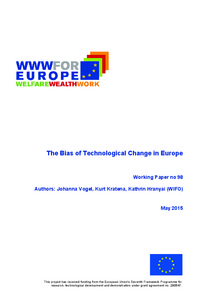The bias of technological change in Europe
"This paper is concerned with measuring and influencing the direction of technological change. First, it provides a comprehensive assessment of the factor bias of technological change using panel data from the World Input-Output Database (WIOD) for 25 EU countries from 1995 to 2009. We measure...
| Main Authors: | , , , |
|---|---|
| Institution: | ETUI-European Trade Union Institute |
| Format: | TEXT |
| Language: | English |
| Published: |
Vienna
2015
WWWforEurope |
| Subjects: | |
| Online Access: | https://www.labourline.org/KENTIKA-19112291124919304739-The-bias-of-technological-chan.htm |
| Summary: | "This paper is concerned with measuring and influencing the direction of technological change. First, it provides a comprehensive assessment of the factor bias of technological change using panel data from the World Input-Output Database (WIOD) for 25 EU countries from 1995 to 2009. We measure the bias with respect to the inputs capital, energy, non-energy materials and three types of labour (low-, medium- and high-skilled). For this purpose, the factor cost share approach based on the duality of production theory is applied. Estimating the system of cost share equations derived from a translog cost function, we find that technological change was low- and medium-skilled labour-saving, high-skilled labour-using, and energy- and materials-using. Second, the paper addresses the question how technological change could be redirected towards saving more energy and less labour. Patent applications in energy- and labour-saving technology fields are used to model the direction of technological change. We construct stocks of patents in these fields and integrate them into the system of cost share equations as proxies for the level of technology. Upon finding that they were indeed energy and labour saving over our sample period, we regress them on policy variables to identify instruments for shifting the bias away from saving labour towards saving energy. We conclude that one way to achieve this, at least partly, would be an increase in the energy tax rate coupled with a matching reduction in the social security contributions paid by employers for low-skilled workers." |
|---|---|
| Physical Description: | 49 p. Digital |

